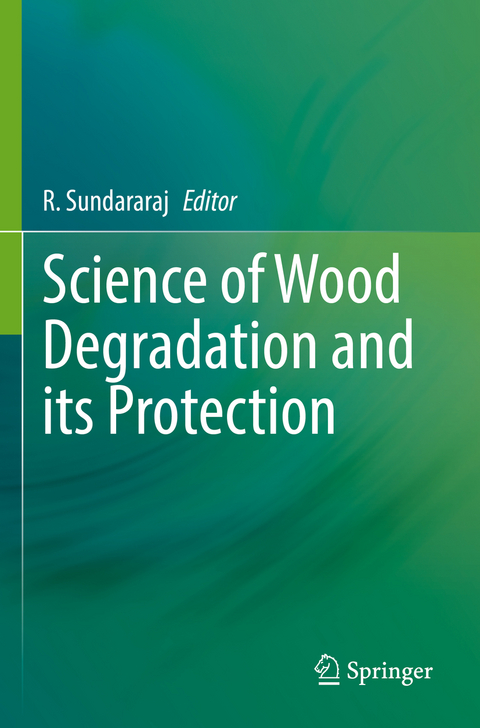
Science of Wood Degradation and its Protection
Springer Verlag, Singapore
978-981-16-8799-0 (ISBN)
Dr. R. Sundararaj, has 35 years of research experience in the field of Protection of wood from bio-deterioration, Forest Entomology, Integrated Pest Management with special reference to sandalwood and Whitefly taxonomy. He obtained M.Sc. (Zoology.) from Madurai Kamaraj University and M.Phil and Ph.D. from University of Madras, Chennai. Published more than 250 scientific papers in renowned International and Indian journals. He has guided 11 students for Ph.D. degree and three post-doctoral fellows. Dr. R. Sundararaj is Fellow of the Royal Entomological Society, London, UK, Fellow of the Entomological Society of India, New Delhi and Fellow of the Applied Zoologists Association of India. Recipient of several awards notably Guru Vandhana Appreciation award from Rotary Bangalore South and Karnataka Civil Defense Corps and Rao Sahib Dr. T.V. Ramakrishna Ayyar Memmorial Award from Dr. B. Vasantharaj David Foundation, Chennai. Presently he is serving as Scientist G and Head, Forest Protection Division of Institute of Wood Science and Technology, Bangalore, an Institute under the umbrella of Indian Council of Forestry Research and Education, under Ministry of Environment, Forest and Climate Change, Govt. of India.
Chapter 1. Wood degradation, challenges and mitigation.- Chapter 2. Wood Decay by fungi: Challenges and Prevention.- Chapter 3. Wounding of Trees: The Precursor of Wood Decay.- Chapter 4.Economically important wood feeding insects - their Diversity, Damage.- Chapter 5. Wood degradation by termites: ecology, economics and protection.- Chapter 6. Wood borers of important fruit trees with special reference to Cerambycids.- Chapter 7. Prospects and advances in management of coconut wood borers.- Chapter 8. Teak heart wood borer Alcterogystia cadambae(Cossidae :Lepidoptera) a potential wood pest of teak and its Management.- Chapter 9. Hoplocerambyx spinicornis Newman: major heartwood borer of Sal Shorea robusta and its management in India.- Chapter 10.Bio-deterioration of Sandalwood (Santalum album L.): Agents and their Management.- Chapter 11.Insect borers of bamboo and their management.- Chapter 12. Wood Biodeterioration in marine environment.- Chapter 13. Natural durability of timber in terrestrial and marine realms of India: A contrasting feature.- Chapter 14. Degradation of Wood and Wooden products by insects and their Management.- Chapter 15. Basics of Wood Drying /Seasoning.- Chapter 16. Chemical Preservatives in Wood Protection . Chapter 17. Potential of Botanicals for Wood Protection.- Chapter 18. Preservation of Engineered Wood Composites (Solid wood Plywood, Block boards/Flush doors) made from Plantation Timbers.- Chapter 19. Wood modification for wood protection.- Chapter 20. Advancements in Nanotechnological Applications for Wood protection.- Chapter 21. Biodegradation: A Vital Component in Life Cycle Assessment of Wood.- Chapter 22.Invasion of wood degraders through wood import and need to strengthen the plant quarantine measures in India.
| Erscheinungsdatum | 22.03.2023 |
|---|---|
| Zusatzinfo | 1 Illustrations, black and white; VII, 744 p. 1 illus. |
| Verlagsort | Singapore |
| Sprache | englisch |
| Maße | 155 x 235 mm |
| Themenwelt | Naturwissenschaften ► Biologie ► Botanik |
| Naturwissenschaften ► Biologie ► Ökologie / Naturschutz | |
| Weitere Fachgebiete ► Land- / Forstwirtschaft / Fischerei | |
| Schlagworte | Phytosantitory measures • wood decay • wood deterioration • Wood Protection • Xylophagous insects |
| ISBN-10 | 981-16-8799-4 / 9811687994 |
| ISBN-13 | 978-981-16-8799-0 / 9789811687990 |
| Zustand | Neuware |
| Haben Sie eine Frage zum Produkt? |
aus dem Bereich


